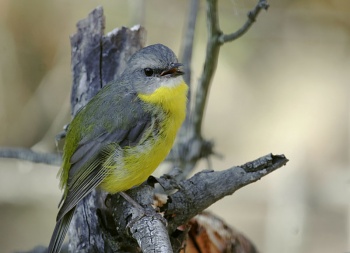m |
(→External Links: Multiple GSearches combined) |
||
| (8 intermediate revisions by 3 users not shown) | |||
| Line 1: | Line 1: | ||
| − | + | [[Image:Yellow_Robin.jpg|thumb|500px|right|Nominate subspecies<br />Photo © by {{user|Neil|Neil fifer}}<br /> Sydney, [[Australia]], July 2006]] | |
| − | [[Image:Yellow_Robin.jpg|thumb| | ||
'''Alternative name: Yellow Robin''' | '''Alternative name: Yellow Robin''' | ||
| + | |||
;[[:Category:Eopsaltria|Eopsaltria]] australis | ;[[:Category:Eopsaltria|Eopsaltria]] australis | ||
==Identification== | ==Identification== | ||
| − | + | [[Image:Eastern Yellow-robin-74.jpg|thumb|350px|right|Subspecies ''chrysorrhos''<br />Photo © by {{user|Ken+Doy|Ken Doy}}<br />Toowoomba Shire, [[Queensland]], [[Australia]], September 2018]] | |
| + | 13·5–17 cm (5¼-6¾ in)<br /> | ||
*Mid grey upperparts and head | *Mid grey upperparts and head | ||
| − | *Bright yellow underparts and | + | *Off-white [[Topography#Heads|supercilium]] |
| + | *Blackish [[Topography#Heads|lores]] | ||
| + | *Bright yellow underparts | ||
| + | *Olive rump and upper tail [[Topography#General Anatomy|coverts]] | ||
*White chin and upper throat | *White chin and upper throat | ||
| + | ====Variations==== | ||
| + | Subspecies ''chrysorrhos'' has a yellow rump and upper tail coverts. | ||
==Distribution== | ==Distribution== | ||
[[Australia]]: found in [[New South Wales]], [[Queensland]], [[South Australia]], [[Victoria]] | [[Australia]]: found in [[New South Wales]], [[Queensland]], [[South Australia]], [[Victoria]] | ||
==Taxonomy== | ==Taxonomy== | ||
| − | ====Subspecies<sup>[[#References|[1]]]</sup> | + | ====Subspecies==== |
| + | [[Image:1421MG 6819b.jpg|thumb|350px|right|Immature, nominate subspecies<br />Photo © by {{user|julien|julien}}<br />Nungurner, [[Victoria]], [[Australia]], February 2006]] | ||
| + | There are 2 subspecies<sup>[[#References|[1]]]</sup>: | ||
*''E. a. chrysorrhos'': | *''E. a. chrysorrhos'': | ||
:*Eastern [[Australia]] (Cooktown, [[Queensland]] to Hunter River, [[New South Wales]]) | :*Eastern [[Australia]] (Cooktown, [[Queensland]] to Hunter River, [[New South Wales]]) | ||
| Line 20: | Line 28: | ||
==Behaviour== | ==Behaviour== | ||
====Diet==== | ====Diet==== | ||
| − | The diet | + | The diet consists of invertebrates and insects such as tics, spiders, flies, moths, wasps and grasshoppers. |
| + | |||
| + | They feed on the ground, descending on their prey from a low branch. | ||
====Breeding==== | ====Breeding==== | ||
| − | + | [[Dictionary_M-O#M|Monogamous]] but communal breeders. The cup-shaped nest is formed from fine plant material and spider's web, disguised with lichen, moss, bark, or leaves. | |
==References== | ==References== | ||
| − | #{{Ref- | + | #{{Ref-Clements6thAug18}}#Avibase |
#BF Member observations | #BF Member observations | ||
| + | #Handbook of the Birds of the World Alive (retrieved Nov 2017) | ||
#Wikipedia | #Wikipedia | ||
#Lamington National Park | #Lamington National Park | ||
{{ref}} | {{ref}} | ||
==External Links== | ==External Links== | ||
| − | {{GSearch|Eopsaltria | + | {{GSearch|"Eopsaltria australis" {{!}} "Eastern Yellow Robin"}} |
| + | {{GS-checked}} | ||
| + | <br /> | ||
| + | <br /> | ||
[[Category:Birds]] [[Category:Eopsaltria]] | [[Category:Birds]] [[Category:Eopsaltria]] | ||
Latest revision as of 12:10, 21 December 2022
Alternative name: Yellow Robin
- Eopsaltria australis
Identification
13·5–17 cm (5¼-6¾ in)
- Mid grey upperparts and head
- Off-white supercilium
- Blackish lores
- Bright yellow underparts
- Olive rump and upper tail coverts
- White chin and upper throat
Variations
Subspecies chrysorrhos has a yellow rump and upper tail coverts.
Distribution
Australia: found in New South Wales, Queensland, South Australia, Victoria
Taxonomy
Subspecies
There are 2 subspecies[1]:
- E. a. chrysorrhos:
- Eastern Australia (Cooktown, Queensland to Hunter River, New South Wales)
- E. a. australis:
- South-eastern Australia (central New South Wales to Victoria and south-eastern South Australia)
Habitat
Mainly coastal areas, in shaded forest undergrowth and woodland, occasionally mallee, mulga and other scrub. Rainforests, scrubby eucalypt woodland, urban woodland and along river edges.
Behaviour
Diet
The diet consists of invertebrates and insects such as tics, spiders, flies, moths, wasps and grasshoppers.
They feed on the ground, descending on their prey from a low branch.
Breeding
Monogamous but communal breeders. The cup-shaped nest is formed from fine plant material and spider's web, disguised with lichen, moss, bark, or leaves.
References
- Clements, J. F., T. S. Schulenberg, M. J. Iliff, D. Roberson, T. A. Fredericks, B. L. Sullivan, and C. L. Wood. 2018. The eBird/Clements checklist of birds of the world: v2018. Downloaded from http://www.birds.cornell.edu/clementschecklist/download/
- Avibase
- BF Member observations
- Handbook of the Birds of the World Alive (retrieved Nov 2017)
- Wikipedia
- Lamington National Park
Recommended Citation
- BirdForum Opus contributors. (2024) Eastern Yellow Robin. In: BirdForum, the forum for wild birds and birding. Retrieved 24 May 2024 from https://www.birdforum.net/opus/Eastern_Yellow_Robin
External Links
GSearch checked for 2020 platform.






